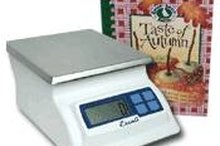Definition and Importance of the Serving Size
You may think you know what a serving size looks like, but it can be easy to eat more than you should because restaurants are in the habit of serving “super-sized” meals. The best way to be sure you’re eating the right amount of calories -- and to be confident you’re getting the nutrition you need to maintain a healthy lifestyle -- is to learn about the recommended serving sizes.
Definition
Developed by the United States Department of Agriculture, the serving size defines a specific amount of a particular food that represents the recommended portion for one sitting. The serving size creates a standard reference used on food labels.
Importance
How Many Calories to Lose 40 Pounds?
Learn More
The standardized serving size is one tool you can use to be sure you’re following a healthy, balanced diet. The United States Department of Agriculture determined that nutritional values be contained in the defined serving size. This information must be placed on food packages in the form of a Nutrition Facts label for easy access to information about the calories, fats, protein, fiber, carbohydrates, vitamins and minerals in one serving. Getting into the habit of reading the label helps you adjust your daily intake to meet your needs.
- The standardized serving size is one tool you can use to be sure you’re following a healthy, balanced diet.
Serving Sizes
The first line on the Nutrition Facts label tells you what the serving size is for that particular food item, followed by the number of servings in that package. If you haven’t paid attention to the defined serving sizes, you might be surprised to discover that they are smaller, or possibly larger, than you realized. If you’re concerned about weight gain, compare the serving size with the portion you normally eat 1. You may discover you’re eating twice the number of calories you need each day. At the start, it may seem like a lot of information to compute, but serving sizes remain consistent 1. For example, one serving of meat is 3 oz., a serving of fruit is 1 medium-sized piece, a serving of bread is 1 slice, and for drinks and cooked vegetables, it’s 1 cup.
- The first line on the Nutrition Facts label tells you what the serving size is for that particular food item, followed by the number of servings in that package.
Guides
Audit Tools for Nursing Care Plans
Learn More
Some guides are available online that provide visual examples of serving sizes so you don’t have to worry about weighing or measuring your portions. One cup of cooked pasta is about the size of a tennis ball; one serving of hard cheese is 1 oz., which is the size of four dice; and a 3-oz. serving of beef, chicken or pork is the size of an adult’s palm, according to Loyola Marymount University.
Related Articles
References
- Meals Matter; Portion Distortion: Serving Sizes are Growing
- U.S. Food & Drug Administration. CFR- Code of Federal Regulations Title 21. Updated April 1, 2019.
- Institute of Medicine (US) Committee on Examination of Front-of-Package Nutrition Rating Systems and Symbols. History of nutrition labeling. In: Wartella EA, Lichtenstein AH, Boon CS, eds., Front-of-Package Nutrition Rating Systems and Symbols: Phase I Report. Washington (DC): National Academies Press (US); 2010.
- Rolls BJ. What is the role of portion control in weight management?. Int J Obes (Lond). 2014;38 Suppl 1(Suppl 1):S1–S8. doi:10.1038/ijo.2014.82
- U.S. Department of Agriculture. Food portions and servings. How do they differ?. Updated March 1999.
- U.S. Food & Drug Administration. Food Serving Sizes Getting a Reality Check. Updated July 16, 2016.
- U.S. Food & Drug Administration. Changes to the Nutrition Facts Label. Updated July 10, 2020.
- U.S. National Library of Medicine. Portion Size. Updated July 14, 2018.
Writer Bio
Sandi Busch received a Bachelor of Arts in psychology, then pursued training in nursing and nutrition. She taught families to plan and prepare special diets, worked as a therapeutic support specialist, and now writes about her favorite topics – nutrition, food, families and parenting – for hospitals and trade magazines.









